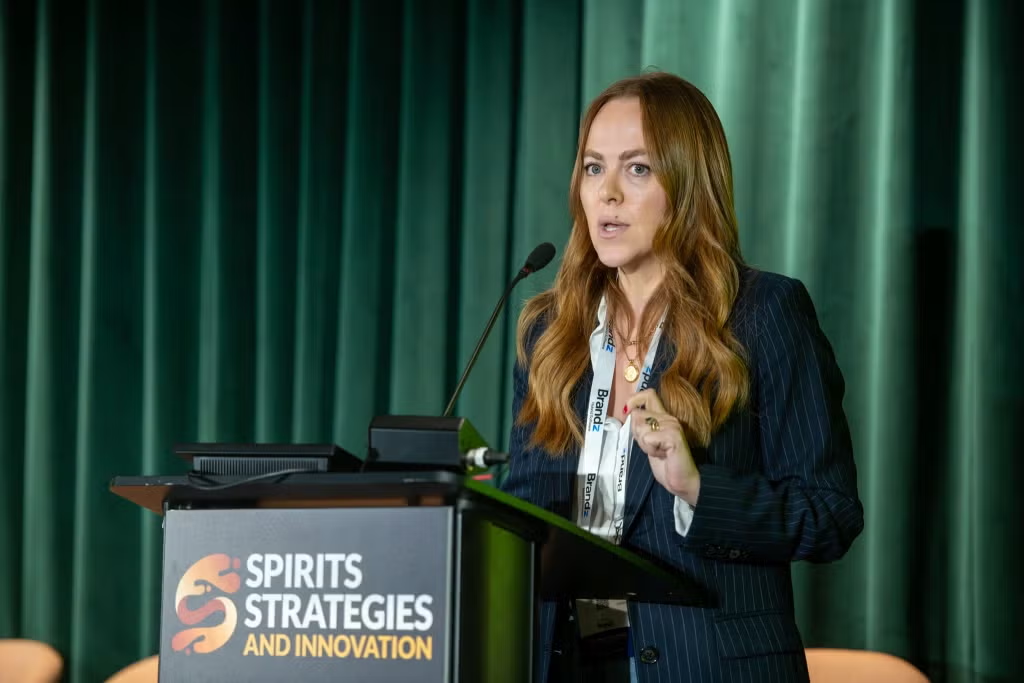
Amid geopolitical tensions, trade spats, drinkers’ interest in moderation and muted consumer confidence across major markets, 2025 has been no doubt a bumpy ride for many in spirits.
As we head into 2026, spirits-industry executives will be hoping trading conditions will ease but delegates at the recent Spirits Strategies and Innovation Conference 2025 conference in London discussed some of the challenges they expect to continue facing the sector.

Discover B2B Marketing That Performs
Combine business intelligence and editorial excellence to reach engaged professionals across 36 leading media platforms.
The event, hosted by Arena, Just Drinks’ sister events arm last month, saw plenty of discussion around attracting younger drinkers, specifically Gen Z (legal drinking age consumers born between 1997 and 2012) and why brands need to adapt how they understand ‘premiumisation’, the trends that had fuelled the growth of the sector for the first couple of decades of the 21st century but which has lost some of its momentum in recent quarters.
Adapting to new consumers
An increasing area of concern for spirits and alcohol producers more broadly has been Gen Z and their consumption of alcohol (or lack of it) and it proved a hot topic at this year’s conference.
Plenty of research has come out over the past year to suggest these consumers are moving away from alcohol but the topic has sparked debate, with some analysts and industry players underlining these younger drinkers do still have an interest in abv.
Ahmad Khan, a consumer analyst at Global Data, Just Drinks’ parent, said the Gen Z cohort has fewer regular drinkers than previous generations.

US Tariffs are shifting - will you react or anticipate?
Don’t let policy changes catch you off guard. Stay proactive with real-time data and expert analysis.
By GlobalData“Generation Z’s regular drinkers are half the equivalent share of millennials, and these figures support the headline view that Generation Z are less committed drinkers with a more occasion-specific relationship to alcohol, like social consumption at parties, et cetera,” he said.
GlobalData’s researchers recommend producers take on cross-category partnerships to attract Gen Z, especially in RTD spirits and realising the potential of the low-and-no alcohol category.
The data and analytics group also recommended honing in on “premium, must-have drinks”, with categories like mainstream beer no longer being an area that alcohol producers can count on. “That means memorable flavours, packaging and the setting within which they consume,” Khan said.

However, just because this younger cohort is consuming less, it doesn’t necessarily mean they’re the core consumer base of no-and-low-alcohol products.
On a separate panel on moderation, James Shillcock, global commercial director at UK alcohol-free business CleanCo, was asked whether Gen Z was driving non-alc sales. He said: “I personally think that the conversation around Gen Z driving this category is massively overblown.” He added that retail data for CleanCo’s non-alc spirits shows that most of its consumers are between 40 and 50.
Marian Bruce, director and founder of Scottish distiller Highland Boundary agreed, adding there are younger consumers who drink alcohol but choose to do it “in different ways, in different settings”.
She stressed younger drinkers are not “a single category” and consumer cohorts are hard to categorise. “It’s so diverse that it’s uncategorisable because [of] the diversity of individuals and how they’re behaving across different age categories,” Bruce said.
GLP-1 and smaller formats
When it comes to attracting younger drinkers, one avenue mentioned during the event was RTDs – and that’s for both alcohol and low-and-no. UK-based non-alc brand Botivo has launched a canned format this year for its drinks, available online and in local retailer Waitrose.
“We know from research and talking to people that loads of young people are drinking our product or restaurants and bars but the format of a bottle doesn’t work for 20- to 40-year-olds and they don’t have fizzy water and an orange in their fridge,” Botivo co-founder Imme Ermgassen said.
While smaller formats was where Botivo saw younger consumers leaning, Ermgassen admitted shifting to RTDs won’t necessarily drive massive revenue growth.
“They are drinking less. I think that is the reality. Are they driving the revenue… in the category? No, because you don’t get that as much revenue by cans as you do in bottles.”
Aside from younger generations looking for alternative formats to full-size bottles, the growing use of GLP-1 weight-loss drugs was also discussed as an overarching trend that is having an impact on food and drinks, by shrinking portion sizes.
Recent findings from GlobalData have suggested the rising use of GLP-1s to be a “structural disruption” to food and drinks and “not a fad”.
Citing research from US non-profit RAND, GlobalData said more than 5% of all US adults are taking the drugs and at least 12% have tried them more than once. Usage could grow by around ten times by 2035, GlobalData adds.
Nik Keane, chief marketing officer of non-alcoholic RTD spirits producer DioniLife, said that GLP-1s is a topic “the industry doesn’t want to talk about”.
While there has been plenty of social stigma around the drugs, and their high price is still a hurdle to broad adoption, once the patents expire, this could make them as affordable as an own-label pack of painkillers – and that will have implications for the drinks industry, he says.
“Beyond all the food stuff, the implication of that is actually people take less liquid. Forget alcohol and spirit: people on this medication taking less liquid in and, the liquids that they’re choosing to have, they’re avoiding stuff that’s high in calories or high in sugar.”
One of the possible implications of this could be that it opens up the opportunity for new products and smaller formats, like “tiny cocktails”, said Keane, noting that these were offered at this year’s on-trade festival London Cocktail Week.
The ‘favourite beige word’
If there’s one word you hear again and again in the spirits (and broader alcohol) industry when discussing growth strategy, it’s the p-word: premiumisation. And the term was, unsurprisingly, mentioned several times during the conference.
Premiumisation has often touted as being key to growth in spirits and key driver of consumer purchases. However, Rachel Vaughan, chief marketing officer at whisky distiller Compass Box, had a slightly different take, arguing “premiumisation” as it is currently being discussed in the industry is no longer beneficial, and what producers need to focus on is “building desire” with their brands.
If you’re in this room and your premiumisation strategy starts with a price point you’re completely missing the point
Rachel Vaughan, Compass Box
“Premium is kind of our industry’s favorite beige word,” Vaughan said. “We slap it on things and then we think that immediately whatever we’re selling is going to be worth more. Too many brands think of it like that. It’s price, it’s packaging, it’s part of the portfolio and maybe it’s even the heritage stories that we love to tell in our marketing spiels”.
But if businesses want to attract drinkers in the future, they need to tweak how they use premiumisation as part of their growth strategy, she said.

“Drinkers of tomorrow, when they’re looking for these types of brands, what they want are meaningful stories, not hollow status. They don’t want to be told something is better… They want to feel that it is special and therefore worth more to them, that it’s going to reward them. If you’re in this room and your premiumisation strategy starts with a price point you’re completely missing the point.”
Instead, Vaughan argued, brands should be focused on bringing specific emotions to the fore for consumers, not elements of sophistication or indulgence but more “unexpected emotions” like nostalgia, rebellion or curiosity.
She added consumers are looking for “experience” and that brands should be able to offer drinkers something unique that they can’t find from others. However, she cautioned such experiences shouldn’t be too aspirational in the sense that drinkers can’t access them.
“Experience in this new world is about every single touch point that a consumer interacts with, and that modern luxury mindset has flipped,” Vaughan said. “People don’t want to be on the outside looking in: ‘I can’t get to it, therefore, it’s aspirational.’ What people find aspirational now is being invited into the circle, not keeping them at arm’s length.”
An example of making premium products more accessible, at Compass Box, Vaughan said, was how it shares recipe wheels and fact sheets alongside its whiskies. These recipe wheels provide a detailed breakdown of the blend of whiskies it sources from for each of its products.
“Whenever we release a new whisky… if we haven’t put the recipe wheel on the website in time, it’s the first thing that people ask us about,” she said.
“They want this access, and that, to them is super desirable. Mystery plays a part. We know that but really trust and access is priceless.”
Flavour in focus
As well as the growing interest in moderation, some in the industry believe there has been a rise in drinkers focusing more on flavour when buying spirits.
Raj Batra, founder and CEO of UK-based distillates supplier Distiil, said the noughties were “dominated by heritage and tradition” for spirits brand, the 2010s, were defined by “craft and premiumisation” and, in the 2020s, “flavour has become the new organising principle”.

More consumers looking to buy on taste instead of a particular category, Batra said. Referring to the on-trade specifically, he added: “Menus are increasingly being structured by flavour families: floral, savoury, citrus, smoky, rather than by spirit type. In short, category used to define flavour. Now flavour defines category.”
In short, category used to define flavour. Now flavour defines category
Raj Batra, Distiil
This increasing focus on flavour is driven by several factors, he added, including expanding consumer palates, attributed to growing consumer curiosity, global spirits such as baijiu and soju becoming better recognised by drinkers, and on-trade innovation with serves.
Interest in and demand for good flavour is also a key focus when drinkers decide to opt for a non-alcoholic drinks brand, according to Botivo’s Ermgassen. While moderation is a driver of non-alcoholic drinks consumption, flavour, she argued, is playing a more significant role.
“When we did a study of our customers recently, people always expect health and wellness come out on top. But, actually, the main driver to Botivo, 90% was taste, and health was only 35% so there was a massive inversion of, I think, what is often expected from an alcoholic category [about] what the driver is.
For me, yes, health and wellness, people are wanting to feel good but, actually, what we’re seeing is a sort of revolution as well in what drinks are out there. When I look at what happened in foods, you know, 15 to 20 years ago, and the explosion of people being super-excited by different flavours, countries and cuisines and fusions and how that really exploded in the restaurant scene, I feel like we’re moving into that similar era.”
Alongside flavour, Batra at Distiil said he believed the industry would be seeing more influence from spirits of the Global South, including Latin America and Africa, as well as a growing focus on “provenance” and transparency around spirits sourcing.
He also forecasted further collaboration between brands, chefs and other figures. The business itself has launched spirits products alongside brands like Doritos and London-based coffeehouse chain WatchHouse, projects which Batra said “differentiate venues, de-risk innovation and teach guests through flavour”.





